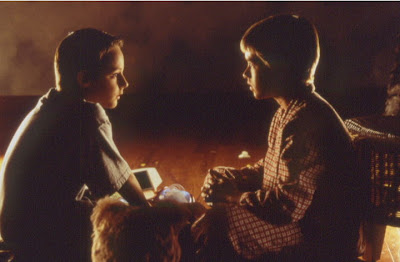The other side of Real
Just a little virtual, brecht food for thought...
From Spielberg's A.I.
Like Sean Stewart said in an interview, talking about ARG's ; "...The initial conceit of AI ( the Steven Spielberg film Based on Brian Aldiss's short story Super-Toys Last All Summer Long) is that it’s storytelling as archeology—or, possibly, the other way around. That is, you work out a story, you create all the evidence of that story, then you smash the evidence into a thousand teeny bits and sprinkle it around and people gather it up, put it together again and argue about what it must have meant about the civilization. Everything you find is real within the fictional bubble of the story.
Storytelling as archeology and Real life as a medium, that seems to be one of the main characteristics of Interactive Storytelling in many ways. Thinking about possible antecedents to ARG's and IST Bertolt Brecht's theatrical forms come to mind. His (successful) attempts to break the so called "fourth wall" and directly engage the audience. seems to predict the ARG concept.
I also remember a film that caused a great impression in my :-) young impressionable mind in 1968, "The Magus" with Michael Caine and Anthony Quinn. This film was based on a novel by John Fowles that dealt with a "behind the curtain" dark psychological manipulations which blur the distinction between fiction and reality (I won't spoil it for you if you want to read it or watch the film). The trickster in the story resembles in a way the role of the Game Master in ARG's.
Many years ago (1988) I worked for a game company that ran an online science fiction "space conquest game"" (AOL's QuantumLink) which provided a model that let the audience influence the storytelling in a very direct way by interacting with us, (the main characters in the game) that had to respond daily to situations created by the users of the game by literally modifyng the story, introducing new characters or situations etc. There was a phone line that connected to the mothership of the federation and if a player got through they could speak with one of the "officers" We took turns on the phone, it was fun and very exhausting! but, ooohhh, was the audience engaged!

Comments
This leads me back to thinking about the location-based street game with a web component called FIASCO. Real life is the medium. Players can do whatever they'd like to with whatever objects they'd like to use so long as they record and upload their actions to be viewed by the community. So, the storytelling emerges from an environment with unlimited outcomes. As pieces of the story are told, the story evolves. People can play anytime, even when their competitors are not logged in.
So, yes, real life is definitely the medium. FIASCO uses archeology in the sense that players must uncover past actions, locations and objects in order to understand the evolving story, interact with it, and continue to develop it.